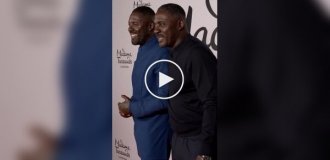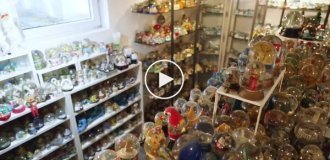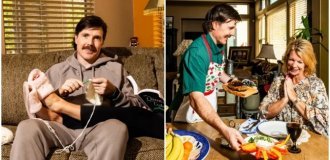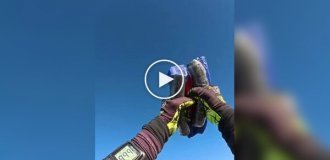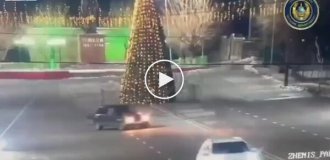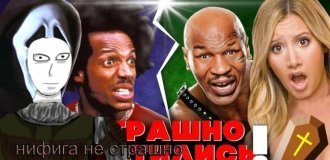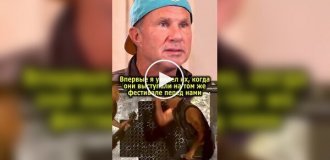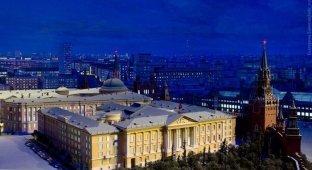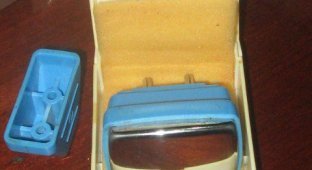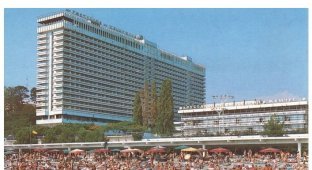Against the backdrop of the inaccessibility of cars, the popularity of motorcycles in the USSR reached a truly epic scale. It is not surprising that the first “clubs of interest” were born in this environment, which eventually resulted in a mass movement of rockers that swept the entire country.

The biker movement originated in the USA in the 1950s and almost immediately became a “protest” movement, attracting “selected” youth who wanted freedom and new opportunities. In the USSR, after the Great Patriotic War, the “motorcycleization” of the country proceeded at an accelerated pace, but in a more peaceful direction: relatively inexpensive and accessible motorcycles became an everyday means of transportation for all ages and segments of the population, transportation of various goods, including building materials for dachas, travel equipment.

In the mid-60s, several factories produced motorcycles, mopeds and scooters - up to 350,000 IZhs per year - which were not much inferior in quality to their foreign counterparts. In the 1970s and 80s, it became easier to buy a car, and adults started driving cars. Motorcycles as a means of transport remained in the countryside, and in the cities they began to attract young people - just at this time, echoes of the biker movement from the USA reached the USSR.

However, in the Soviet Union, informal associations of young people on motorcycles were called “rockers” rather than bikers. This term appeared in the early 80s and denoted Soviet rock music fans who tried to copy the style of British “coffee bar cowboys” and American bikers. But since many fans of hard rock in large cities already rode motorcycles, the term “rocker” soon spread to young motorcyclists in general, and to members of the first domestic motorcycle clubs in particular.

But for the Soviet “rocker,” especially in the provinces, it was not so important what ordinary people called him. From adolescence, the guys helped their fathers fix their motorcycles, collected spare parts from landfills and built equipment themselves; many took part in free motocross and karting sections.

We gradually saved money and bought our own lightweight, relatively inexpensive, domestically produced motorcycles: “IZH Planet”, “IZH Planet Sport”, “Minsk”, “Voskhod”. In the 1970s and 80s, Voskhod cost 450 rubles. - this is 3-4 average salaries.
The motorcycle was unpretentious, economical, lightweight and repairable, although not particularly reliable. But many learned to repair internal combustion engines on it. “IZH Planet” already cost 625-750 rubles. (4-5 average salaries), but at the same time the cheapest car - "Zaporozhets" - was sold for 3000-3750 rubles.

"Sunrise"

"IZH Planet Sport"

Jawa 350
There were also “foreign cars” in the Soviet motorcycle fleet. For example, Czechoslovakian Jawa motorcycles were supplied to the USSR from the mid-50s, and by the 70s almost every third motorcyclist rode them, and in total there were more than a million Jawas in the USSR, which were valued for their reliability, power, versatility and ease of use. maintenance and repair.

The most fashionable model in the USSR was the Java-638, which began to be produced in 1984. It had a two-stroke two-cylinder engine with a volume of 343 cubic meters and a power of 26 hp. s., the maximum speed of the motorcycle was 120 km/h.

Pannonia
In addition to Jawa, Hungarian Pannonia motorcycles were popular, equipped with a single-cylinder 250 cc two-stroke engine, a four-speed gearbox, a closed chain drive and a duplex frame. From 1954 to 1975, 287,000 motorcycles of this brand were imported into the USSR. The most successful model was the Pannonia 250 TLF: the motorcycle weighed 146 kg, had an 18-liter tank, boasted reliable electrics, and its engine produced 18 hp. With. power. In addition to this model, the plant produced motorcycles with a 350 cc engine and a sidecar.


CZ 350
Another successful motorcycle of those years was the Czechoslovakian CZ - “Cheset”. The dream of an entire generation was produced since 1962 and was equipped with a single-cylinder two-stroke engine with a displacement of 350 cm3.

CZ Cross 250

But the “rocker” movement in the USSR was inextricably linked precisely with IZh motorcycles and the iconic Czechoslovak “Java”. In the cities, taxi drivers were the first to buy Java cars: in the 60-70s they earned 100-120 rubles. per month, depending on the class of the driver, and, in addition, they often sold vodka or counterfeit goods under the counter, having a considerable additional income. Taxi drivers were then in fashion with eight-piece caps and brown leather jackets, which they bought from military pilots. In the evenings after work, they got together with colleagues and rode motorcycles.

At that time it was not necessary to wear a helmet. But as the number of motorcycles grew, so did the number of accidents involving them, and then drivers were required to wear helmets. However, at first there were not enough helmets for everyone, and they were poor and made of iron. Such a “helmet” spoiled the dashing appearance of a motorcyclist on a “Java” - that’s when the division began into the 1% of hooligans who did not recognize helmets, prohibitions on crowd gatherings and traffic rules, and the remaining 99% of law-abiding motorcyclists. But over time, when more modern plastic helmets began to arrive from the Baltics, most motorcyclists switched to them: they could be painted, visors and muzzles attached, and generally “customized” in every possible way.

The “rockers” usually gathered on Friday evenings and weekends near city parks and other public places to hang out with friends and chat with girls. In Moscow, the most popular places in the 80s were Gorky Park, “Luzha” (Luzhniki Stadium), “Mkhat” (the area near the theater of the same name), and “Solyanka” (salt cellars on the Lubyanka). Motorcyclists also met at “Kuzna” (Novokuznetskaya metro station), in the cafe “On Malaya Bronnaya”, in “Mayak” and, of course, on “The Mountain” (the observation deck of the Sparrow Hills opposite the main building of Moscow State University), where they still gather now.

After communicating on the spot, the “rockers” got on their motorcycles and rode around the city at night. It must be said that until the 90s, the traffic police did not stand on ceremony with “rockers”: they drove them away from party places, and organized chases on the roads, they could even use weapons against especially arrogant ones. But the crazy motorcyclists of those years allowed themselves to ride not only without documents (having a “licence” of category “A” until the early 2000s was considered almost bad manners!), but also without observing any traffic rules: in a crowd in oncoming traffic, along underground pedestrian crossings crossings, on sidewalks, etc. Many accidents also happened: according to statistics, in the late 80s in the USSR, 12 thousand accidents involving motorcyclists occurred per month, in which 1,600 people died. Over the year, there were 68.5 thousand accidents due to the fault of motorcycle drivers, about 10 thousand people died! Today, despite increased speeds and an increased number of cars and motorcycles by several orders of magnitude, there are significantly fewer accidents involving motorcyclists: about 10 thousand accidents per year, in which about 1,200 people die - the monthly “norm” of the USSR in the 80s.

The “rockers” of the 80s enthusiastically engaged in, as they say today, “customizing” their motorcycles - whoever knows what. Ideas were drawn from occasional European and American motorcycle magazines, and later from films like Mad Max. Everything was done with our own hands from scrap materials or from what we managed to get at the “flea market” or get from “over the hill.” They also repaired and tuned the motorcycles themselves—there weren’t even tire shops in the provinces.

The motorcycles were equipped with handlebars with a crossbar or two, “royal” high handlebars without crossbars (ape-hanger type), semicircular arches made from water pipes using a pipe bender and galvanized through a “friend’s father” at some factory. Czechoslovak Velorex windshields, metal chrome glove compartments from Pannonia, lights that turned on along with the low beam and at night left an illuminated spot on the road - from the Vyatka motor scooter, the stoparis and dimensions were altered and replaced with larger ones. The “original” gas handles and brake and clutch levers were immediately removed and replaced with others, for example, from the same “Pannonia”. Rear-view mirrors were mounted on the windshield, and there were also mirrors on the safety arches, through which male drivers looked under the girls’ skirts when they sat in the passenger seat...

The control buttons were chrome-plated from “Pannonia”; they turned on the turn signals and beep signals, which were often made in two different tones, so that for each button there was a signal - with the help of two buttons you could play a “Dog Waltz” or imitate a “siren”. The mufflers were also removed or altered: externally they were left as factory ones, but the insides were cut off to make the sound sharper and louder. Multi-colored light bulbs were attached to the wheels, glowing effectively in the dark and while driving.

By 1988, the rocker movement in the USSR had become so massive and noisy that they even began making films about it, or rather about its detrimental effect on fragile minds, like “Accident is the Cop’s Daughter.” And in the 90s, rockers were finally replaced by bikers on heavy motorcycles with long forks, the first Russian bike clubs and the first not military trophy, but real “biker” Harleys brought from the USA. But that's a completely different story.
